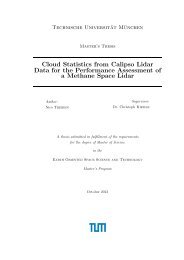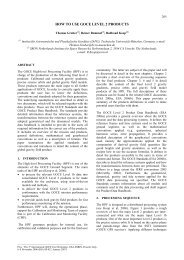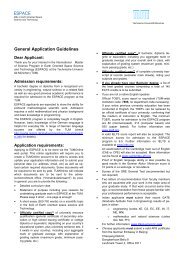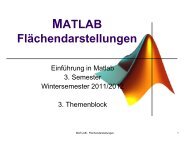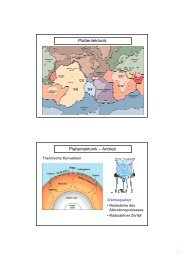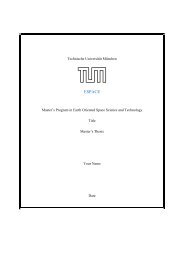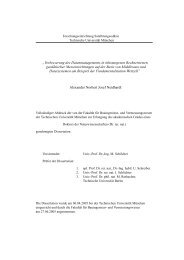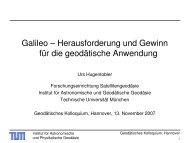FODITS - Institut für Astronomische und Physikalische Geodäsie ...
FODITS - Institut für Astronomische und Physikalische Geodäsie ...
FODITS - Institut für Astronomische und Physikalische Geodäsie ...
Create successful ePaper yourself
Turn your PDF publications into a flip-book with our unique Google optimized e-Paper software.
13. Result and output files are generated.<br />
14. Input files for ADDNEQ2 are updated.<br />
In summary the algorithm consists of adaptation (step<br />
4.), test (step 6.), and identification (steps 9. and<br />
10.) (ATI) steps. The progress of the algorithm can<br />
be given in terms of screening and iteration steps: a<br />
screening step (adaptation and test steps of the ATIprocedure)<br />
is completed with the handling of velocities<br />
(step 7.) while an iteration (identification step of<br />
the ATI-procedure) is completed with the search for<br />
probable outliers (step 10.) (see Figure 2).<br />
There is an important advantage in setting up<br />
the full functional model and removing the nonsignificant<br />
elements. The most computer time consuming<br />
part is the setup of the components of the<br />
functional model from the pseudo-observations, the<br />
elements of the time series, e.g., coordinates. So it<br />
is preferable if only components need to be removed<br />
and no parameters for a new component of the functional<br />
model has to be added within one iteration step:<br />
the removal can be done on normal equation level<br />
whereas adding new parameters requires a reprocessing<br />
of the complete time series. This significantly increases<br />
the speed of the program.<br />
3.3 Tests of Significance<br />
We verify the significance of all estimated parameters<br />
x = {d,s,p} by the following statistical test:<br />
Tx =<br />
m0<br />
|x|<br />
<br />
TQxx(x,x)T<br />
< u1− α<br />
T 2<br />
, (2)<br />
where m0 is the unit weight of the LSA, Qxx(x,x)<br />
is the cofactor matrix of the parameter x, and T is the<br />
transformation matrix of the operation. Moreover, we<br />
have the critical value u1− α of the normal distribu-<br />
2<br />
tion for a user-defined significance level α.<br />
Let’s add two remarks to the significance tests:<br />
First, for periodic functions we test for the significance<br />
of the amplitude. Second, a minimum size of a<br />
detectable discontinuity (|x| > κd · m0) and outlier<br />
(|x| > κs · m0) is specified in relation to the noise<br />
level of the time series and as an absolute threshold<br />
for the horizontal (|xh| > hd, |xh| > hs) and vertical<br />
(|xv| > vd, |xv| > vs) components. In this way, the<br />
computation time can be significantly reduced, and<br />
the user has a better control of the algorithm (e.g.,<br />
events with a size below 1 mm might be detected as<br />
significant in the time series of very good stations,<br />
what makes from the general experience of the GNSS<br />
processing no sense anymore).<br />
3.4 Searching for New Discontinuities<br />
The removal of the most probable discrepancy (in<br />
terms of discontinuity) between the functional model<br />
and the time series requires the identification of the<br />
epoch of such potential discontinuity. In <strong>FODITS</strong>, the<br />
identification of this epoch is based on the analysis<br />
of the time series residuals with respect to the recent<br />
functional model<br />
v(ti) = y(ti) − Ax(ti), (3)<br />
where A is the design matrix of the updated functional<br />
model.<br />
Because the original statistical test for the identification<br />
step in the DIA-procedure as proposed in<br />
(Teunissen, 1998) is very computer time consuming,<br />
we have implemented a simplified algorithm to detect<br />
the epoch of the most probable discontinuity discrepancy<br />
at<br />
td in a way that g(td) = maxg(ti) (4)<br />
with<br />
g(ti) =<br />
<br />
<br />
<br />
i <br />
<br />
w(tk) , where i = 1, . . .,nt. (5)<br />
k=1<br />
The residual time series<br />
w(ti) = v(ti) − A2x(ti) (6)<br />
is obtained by fitting a first degree polynomial function<br />
(described by the design matrix A2) to the original<br />
residual time series v(ti) (see Eq. 3) with the<br />
peculiarity of resampling the time information with<br />
ti = i for i = 1, · · · , nt.<br />
Let’s add a remark to the test time series of Eq. 5:<br />
by employing the residual time series w(ti) (see<br />
Eq. 6) instead of the original residual time series<br />
v(ti) (see Eq. 3) we make the identification step robust<br />
with respect to the data gaps in the time series<br />
(not unusual for time series derived from GNSS data).<br />
3.5 Searching for Additional Outliers<br />
All residuals of Eq. 3 that fulfill<br />
|v(ti)| > κsm0 and (7)<br />
|vh(ti)| > hs or |vv(ti)| > vs<br />
are identified as outliers. Outliers will be added to<br />
the functional model and tested for significance in the<br />
next iteration step of the ATI-procedure.<br />
3.6 Velocity Handling<br />
In long time series the station velocity needs to be<br />
considered. One or more time intervals of velocity parameters<br />
may be considered in the functional model<br />
(see Section 3.1). The (user-defined) criteria to introduce<br />
the velocities in the functional model are:



